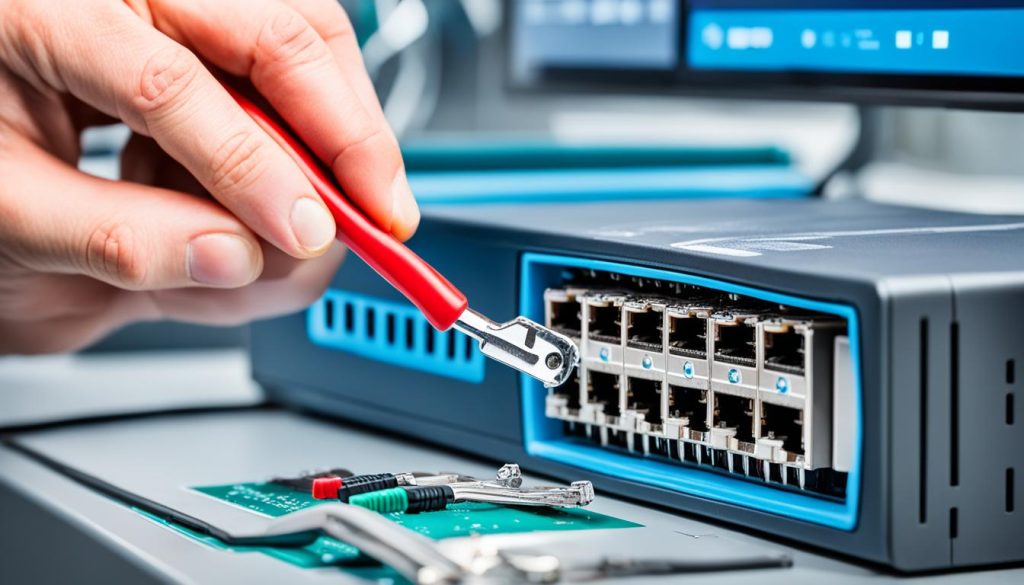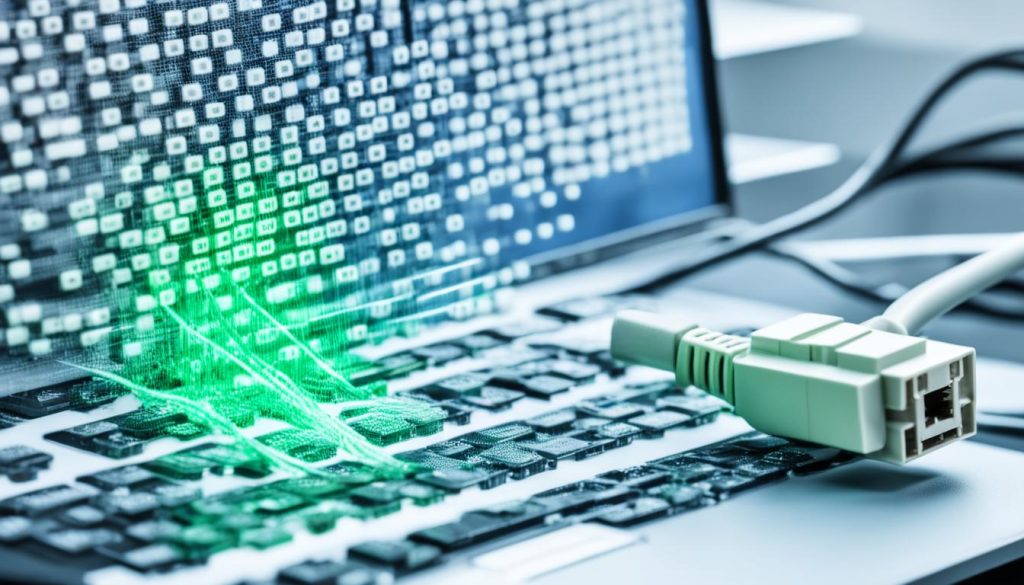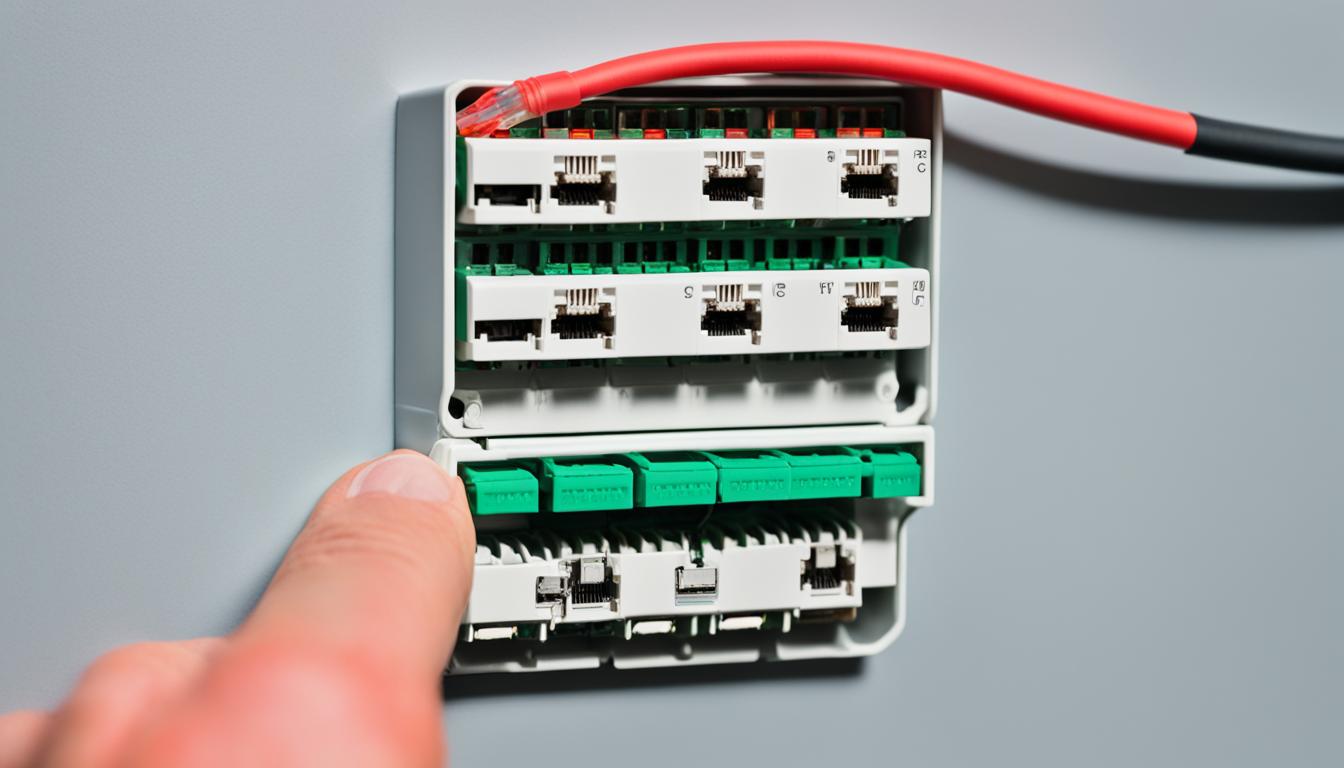If you’re experiencing unstable Ethernet connection issues, it can be frustrating and disrupt your productivity. However, there are several quick fixes you can try to resolve the problem and get your network back up and running smoothly. In this article, we’ll provide you with expert tips on troubleshooting common Ethernet port errors and finding solutions for swift network connectivity fixes.
Key Takeaways:
- Learn how to troubleshoot and fix common Ethernet port errors.
- Check the condition of your Ethernet cable and port for any signs of damage or debris.
- Run network troubleshooters to identify and resolve network-related issues.
- Update your Ethernet adapter’s driver to ensure compatibility and stability.
- Disable any VPN software that may interfere with your Ethernet connection.
Check the Ethernet Cable and Port
When troubleshooting Ethernet connection issues, it’s essential to start by checking the condition of your Ethernet cable and port. These elements play a crucial role in establishing a stable network connection. Here are the steps to follow:
1. Inspect the Ethernet Cable
Old or damaged Ethernet cables can result in an unstable connection. Look for any visible signs of wear and tear, such as frayed or bent connectors or exposed wires. If you notice any damage, consider using a spare cable or connecting the faulty one to a different device to determine if the cable is the root cause of the problem.
2. Examine the Ethernet Port
Inspect the Ethernet port on your device for any signs of damage, such as looseness or debris. A damaged port can hinder the proper connection between your device and the network. If you encounter debris or dirt, gently clean the port using a can of compressed air or a soft brush. This can help eliminate any obstructions that may be affecting the connection quality.
If the Ethernet port is physically damaged, you can try troubleshooting the issue by using a USB-to-Ethernet adapter. This adapter allows you to connect your Ethernet cable to a USB port on your device, bypassing the damaged Ethernet port. Alternatively, you can also try connecting to a different Ethernet port on your router or PC, if available.
“A stable Ethernet connection starts with a reliable cable and a properly functioning port. Take the time to inspect these components to ensure they are in good condition.”
By following these steps and addressing any cable or port issues, you can effectively troubleshoot common Ethernet connectivity problems. Once you’ve ruled out these potential sources of instability, you can proceed with further troubleshooting steps to get your network connection back on track.
Run Network Troubleshooter
When faced with network-related issues, the built-in network troubleshooter tool in Windows 10 can be your best friend. This powerful tool is designed to detect and resolve problems that may be causing an unstable Ethernet connection.
Using the network troubleshooter is easy. Simply navigate to the Windows 10 search bar, type “network troubleshooter,” and select the “Identify and repair network problems” option.
Once launched, the troubleshooter will automatically scan your system and provide you with a detailed report of the detected problems. It will also offer step-by-step instructions on how to fix them.
If the troubleshooter successfully resolves your Ethernet connection issues, congratulations! You can now enjoy a stable network connection.
However, if the troubleshooter is unable to fix the problem, don’t worry. There are further troubleshooting steps you can take.
One potential solution is to update your Ethernet adapter’s driver using Device Manager. Outdated or incompatible drivers can often cause network adapter issues. Follow these steps to update your driver:
- Press the Windows key + X and select “Device Manager.”
- In the Device Manager window, expand the “Network adapters” section.
- Right-click on your Ethernet adapter and select “Update driver.”
- Choose the option to search for drivers automatically.
- Follow the on-screen instructions to complete the driver update.
Updating your Ethernet adapter’s driver may resolve any underlying compatibility issues and restore stable connectivity.
Remember, the network troubleshooter and driver updates are just two of many troubleshooting tools and techniques available to diagnose and resolve Ethernet connectivity problems. Don’t give up if these initial steps don’t solve your issue. The world of network troubleshooting is vast, and there are many more solutions to explore.
Stay tuned for the next section, where we’ll delve deeper into troubleshooting methods and tips for resolving common Ethernet port errors.
| Troubleshooting Tools | Function |
|---|---|
| Network Troubleshooter | Automatically detects and resolves network-related issues |
| Device Manager | Allows you to update your Ethernet adapter’s driver |
 |
Visual representation of troubleshooting tools |
Update Ethernet Adapter’s Driver
An outdated, corrupt, or missing Ethernet adapter driver can cause various connectivity issues. To ensure a stable and reliable Ethernet connection, it is crucial to keep your driver up to date. Follow these steps to update your Ethernet adapter driver:
- Open Device Manager by pressing the Windows key + X and selecting Device Manager from the menu.
- Expand the Network adapters menu to view your Ethernet driver.
- Right-click on the Ethernet driver and select Update driver.
- Choose the option to search automatically for updated driver software.
- Windows will search for the latest driver version online and install it on your device.
- Restart your device to apply the driver update.
After restarting, check if the Ethernet connection is now stable. Updating your Ethernet adapter driver can resolve common connectivity issues caused by outdated or malfunctioning drivers.
By regularly updating your Ethernet adapter driver, you ensure that your network connectivity remains smooth and uninterrupted, and you can make the most of your Ethernet connection.
Disable Your VPN
If you’re facing connectivity issues with your Ethernet connection, it’s worth considering whether your VPN software is interfering with it. Temporarily disabling your VPN can help determine if it’s causing the problem. In Windows 10, follow these steps to disable your VPN:
- Go to Settings.
- Select Network & Internet.
- Click on VPN.
- Remove or disconnect your VPN connection.
Additionally, if you have any VPN extensions installed on your internet browser, disabling or removing them can also help resolve any interference with your Ethernet connection.
By removing or disabling your VPN software, you can assess its impact on your Ethernet connection and potentially troubleshoot the issue further.
VPN and Ethernet Connection
When using a VPN in conjunction with an Ethernet connection, it’s important to be aware of potential interference that might arise. While VPNs can enhance security and privacy, their encryption protocols and server configurations can sometimes conflict with the smooth functioning of Ethernet connections.
Disabling your VPN temporarily can help you troubleshoot and identify if it’s responsible for the instability in your Ethernet connection.
By following the steps outlined above, you can easily disable your VPN software and determine if it resolves the connectivity issue. If your Ethernet connection stabilizes after disabling the VPN, it may be necessary to fine-tune your VPN settings or consider alternative solutions to ensure a seamless network experience.
| Pros | Cons |
|---|---|
| Improved security and privacy | Potential interference with Ethernet connection |
| Access to geographically-restricted content | Slower internet speeds |
| Bypassing internet censorship | Possible compatibility issues with certain applications |
Check Power Management Settings
Windows 10’s power management settings play a crucial role in optimizing the performance and battery life of your device. However, these settings may inadvertently disrupt the functionality of Ethernet connections, leading to unstable network connections.
To ensure that your power management settings are not causing any disruptions to your Ethernet connection, you need to follow these steps:
- Open the Device Manager on your Windows 10 computer.
- Expand the Network adapters menu.
- Right-click on your Ethernet adapter and select Properties from the dropdown menu.
- Navigate to the Power Management tab.
- Uncheck the “Allow the computer to turn off this device to save power” option.
- Click Apply and then OK to save the changes.
By disabling this particular power management setting, you ensure that your Ethernet adapter remains active and operational at all times, providing a stable connection for your network needs.
After making these changes, it is essential to restart your PC to fully implement the modifications. Once your computer restarts, you can check if the Ethernet connection remains stable.
Ensuring that your power management settings are appropriately configured for your Ethernet connection can make a significant difference in maintaining a reliable and uninterrupted network experience.
Check Your Fixed IP Settings
Using a fixed or static IP address for your Ethernet network can enhance speed and security. However, using incorrect static IP information can cause instability. To ensure your IP settings are correctly configured, follow the steps below:
- Go to Settings > Network & Internet > Ethernet > IP settings
- Ensure that the IP assignment is set to “Automatic (DHCP)”
- If it’s set to manual IP assignment, edit the settings
- Select “Automatic (DHCP)” from the drop-down menu
- Save the changes
- Verify if the Ethernet connection is stable
By double-checking your fixed IP settings and ensuring they are set to “Automatic (DHCP),” you can resolve any IP configuration issues that may be causing network instability.

Fixed IP Settings Troubleshooting
| Issue | Possible Cause | Solution |
|---|---|---|
| No Internet Connection | Incorrect static IP address | Check and update IP settings to ‘Automatic (DHCP)’ |
| Intermittent Connectivity | Conflicting or duplicated IP addresses | Ensure each device on the network has a unique IP address |
| Slow Network Speed | Subnet mask or gateway address misconfiguration | Verify subnet mask and gateway address settings |
Review the table above for common fixed IP settings issues and their respective solutions.
Check LAN Proxy Settings
If your PC or laptop uses a proxy server over LAN, it can interfere with the Ethernet connection. To fix this, follow the steps below to disable the proxy settings:
- Open the Run dialog by pressing Windows key + R.
- Type “inetcpl.cpl” and click OK.
- In the Internet Properties window, go to the Connections tab.
- Click on LAN settings.
- Uncheck the option “Use a proxy server for your LAN.”
- Click OK to save the changes.
This should resolve any proxy-related issues with your Ethernet connection.
Troubleshooting LAN Proxy Issues
“Using a proxy server over LAN can sometimes cause disruptions in the Ethernet connection. By disabling the proxy settings, you can troubleshoot and resolve any connectivity issues related to proxy configurations.”
Ensuring that your LAN proxy settings are correctly configured is important for maintaining a stable Ethernet connection. Disabling the proxy server for your LAN will allow your device to connect directly to the network, eliminating any potential conflicts caused by the proxy server. Follow the steps above to disable the proxy settings and optimize your Ethernet connection.
Conclusion
Solving Ethernet port errors requires a systematic troubleshooting approach to identify and resolve common issues affecting network connectivity. By following the tips and methods outlined in this article, you can effectively troubleshoot and fix Ethernet port problems, ensuring a stable and reliable connection.
Remember that network setups can vary in complexity, so it’s important to try multiple solutions to find the one that works for your specific setup. Start by checking the condition of your Ethernet cable and port, as they can often be the source of connectivity issues. Running the built-in network troubleshooter tool in Windows 10 can help identify and resolve network-related problems.
If the issue persists, updating your Ethernet adapter’s driver, disabling VPN connections, checking power management settings, reviewing fixed IP settings, and examining LAN proxy settings can all contribute to a more stable Ethernet connection. However, if you continue to encounter persistent issues, it may be necessary to seek professional assistance or consult with your network administrator for further guidance.
In summary, by utilizing the troubleshooting tips and solutions provided in this article, you can effectively troubleshoot and resolve common Ethernet port errors. Remember to perform the necessary checks, try different solutions, and reach out for support when needed to ensure optimal network connectivity and performance.
FAQ
How do I check if my Ethernet cable is causing the unstable connection?
Start by checking the condition of your Ethernet cable. If it’s old or damaged, it may be the culprit. Try using a spare cable or connecting the faulty one to a different device to identify if the cable is the problem.
What should I do if I discover damage to my Ethernet port?
If you find any signs of damage, such as looseness or debris, try cleaning the port. If the port is beyond repair, you can use a USB-to-Ethernet adapter or a different port on your router or PC as an alternative.
How can I run a network troubleshooter in Windows 10?
Use the built-in network troubleshooter tool in Windows 10. It will help you identify and fix network-related issues causing an unstable Ethernet connection. The tool generates a report with detected problems and instructions to resolve them.
What can I do if the network troubleshooter doesn’t fix the issue?
Try updating your Ethernet adapter’s driver using the Device Manager. An outdated or corrupt driver can cause connectivity problems. Right-click on the Ethernet driver in the Network adapters menu, select Update driver, and let Windows install the latest version.
Should I disable my VPN to resolve Ethernet connection issues?
If you’re using a VPN software, temporarily disable it to check if it’s interfering with the Ethernet connection. You can remove or disconnect your VPN connection in the Windows 10 settings and disable any VPN extensions in your internet browser.
How can power management settings affect my Ethernet connection?
Windows 10’s power management settings may reduce Ethernet functionality to save battery power, leading to an unstable connection. Check your Ethernet adapter’s properties in the Device Manager and ensure that the “Allow the computer to turn off this device to save power” option is unchecked.
Is using a fixed or static IP address beneficial for Ethernet connectivity?
Yes, using a fixed or static IP address can enhance speed and security. However, using incorrect static IP information can cause connectivity issues. Check your IP settings in the Windows 10 settings and ensure that the IP assignment is set to “Automatic (DHCP).”
How can LAN proxy settings affect my Ethernet connection?
If your PC or laptop uses a proxy server over LAN, it can interfere with the Ethernet connection. Disable the proxy settings in the LAN settings of the Internet Properties window. This should resolve any proxy-related issues with your Ethernet connection.
What should I do if none of these troubleshooting steps work?
If persistent Ethernet port errors persist, consider seeking professional assistance or contacting your network administrator for further guidance.
